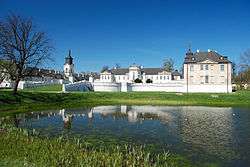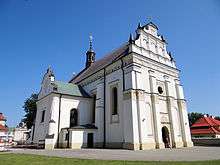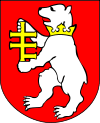Radzyń Podlaski
Radzyń Podlaski pronounced [ˈrad͡zɨɲ pɔdˈlaskʲi] is a town in eastern Poland, about 60 km north of Lublin, with 15,808 inhabitants (2017).[2] Situated in the Lublin Voivodeship since 1999, previously it was part of the Biała Podlaska Voivodeship (1975–1998). It is the capital of Radzyń Podlaski County, and historically belongs to the region of Lesser Poland (despite the adjective Podlaski, which suggests that it is part of another Polish province, Podlasie). The town was founded in 1468, and its most important landmark is the rococo Potocki Palace.
Radzyń Podlaski | |
|---|---|
 Potocki Palace | |
 Coat of arms | |
 Radzyń Podlaski  Radzyń Podlaski | |
| Coordinates: 51°46′58″N 22°37′27″E | |
| Country | |
| Voivodeship | |
| County | Radzyń Podlaski County |
| Gmina | Radzyń Podlaski (urban gmina) |
| Government | |
| • Mayor | Jerzy Rębek |
| Area | |
| • Total | 19.31 km2 (7.46 sq mi) |
| Population (2017) | |
| • Total | 15,808[1] |
| Time zone | UTC+1 (CET) |
| • Summer (DST) | UTC+2 (CEST) |
| Postal code | 21-300, 21-315 |
| Car plates | LRA |
| Website | http://www.radzyn-podl.pl/ |
Radzyń lies on the Białka River within the South Podlasie Lowland, at the height of 150 metres (490 ft) above sea level. The town has the area of 20,29 square kilometers, of which forests make only 5%. It is located along the Expressway S19, which passes through Białystok, Lublin and Rzeszów.
History
In the early years of Polish statehood Radzyń was located in extreme northeastern corner of Lesser Poland, near the border with Ruthenia and the Duchy of Lithuania. The region was frequently raided by its neighbors, which had a negative impact on the economy. This sparsely populated borderland of Lesser Poland began to see improvements after 1385, when Poland and Lithuania became allies under the Union of Krewo. Settlers from other part of Lesser Poland, as well as Mazovia, came to Radzyń, churches were built and villages were founded. According to historical documents, the town of Radzyń was preceded by a settlement called Kozirynek (also spelled as Cozirynek and Kozyrynek; this name appears in documents as late as 1580).
In 1456, first Roman Catholic parish at Radzyń was created, and in 1468, the town was incorporated based on Magdeburg rights. It was a royal possession, leased by kings to different noblemen, such as the Mniszech family. In 1690, King John III Sobieski granted several privileges to town’s residents. At that time, Radzyń had Roman Catholic, Greek-Catholic and Orthodox churches, as well as a synagogue.
18th century

Since 1741 until the late 18th century, Radzyń belonged to the Potocki family, and was part of Lesser Poland's Lublin Voivodeship. General Eustachy Potocki built here a rococo palace. Following the Partitions of Poland at the end of the 18th century, Radzyń was annexed by the Austrian Empire, but in 1815 it became part of Russian-controlled Congress Poland, which was part of the Russian Empire. In 1867 Russian authorities created Radzyń County, which gave the town a boost. Later on, Radzyń got a rail connection with Lublin and Siedlce, and the town began a period of development.
20th century
When Poland regained its independence as the Second Polish Republic, Radzyń was the seat of a county in Lublin Voivodeship. It had a large Jewish minority, and houses of the lower classes were mostly built from wood, which resulted in a large fire in 1930. The houses on the market square were later rebuilt of stone and brick. On September 9, 1939, Radzyń was bombed by the Luftwaffe. In late September of that year, it was one of centers of Polish resistance, with units of Independent Operational Group Polesie stationed there for some time. The first Germans appeared in Radzyń after the Battle of Kock, in early October 1939.
From Radzyń, 6,000 local Jews were sent to Treblinka extermination camp in August 1942 amid gunfire and screams. Some went through the transit point in the Międzyrzec Podlaski Ghetto. The pacification actions were conducted by the Nazi German Reserve Police Battalion 101. The town was a major center of Home Army, with 4,200 members, and the German occupation lasted until July 23, 1944, when the Red Army entered the town. The community was never reconstituted.[3]
Sport
- Orlęta Radzyń Podlaski - football club
Attractions
Among the local points of interest are the St. Trinity Church (1641), built in the so-called Lublin Renaissance style, as well as the Potocki Palace (1740s), built by a Polish-Italian architect Jakub Fontana. Its interior was destroyed twice: in 1915 by Imperial Russian troops, and in 1944 by the Wehrmacht during the occupation of Poland in World War II. The palace was in 1920 the headquarters of General Edward Rydz-Śmigły, during the Battle of Warsaw. Since 1920, it has served as office of local administration.

References
- https://www.polskawliczbach.pl/Radzyn_Podlaski
- https://www.polskawliczbach.pl/Radzyn_Podlaski
- Christopher R. Browning (1998). Arrival in Poland (PDF file, direct download 7.91 MB). Ordinary Men: Reserve Police Battalion 101 and the Final Solution in Poland. pp. 90–100. Retrieved May 1, 2013.
also: PDF cache archived by WebCite.
External links
- Official town website, Radzyn-Podl.pl
- News and prices - Radzyń Podlaski Iledzisiaj.pl
![]()

